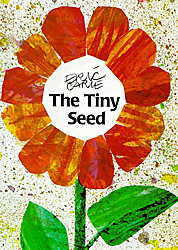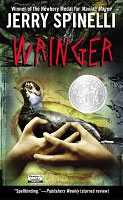Carol Hurst's Children's Literature Site
Newsletter, Volume 15, Number 4
![]()
Three Featured Book Articles: Grades PreK-8
For this issue I have a featured book article for each of three classic books. Each is a teacher guide with a review of the book, discussion topics, activities, related books and links.
The first is The Tiny Seed by Eric Carle which is recommended for grades PreK-2 but which also has uses in the upper grades with it's themes of survival and the life-cycle along with curriculum tie-ins to math, language arts and botany.
Next we'll explore the chapter book Catwings by Ursula Le Guin which is an accessible fantasy of a litter of imperiled kittens who just happen to be able to fly. It's also a wonderful read aloud with three sequels available.
Finally, for the upper grades I have an article about Wringer by Jerry Spinelli. This is recommended for grades 5-8. This haunting book about the ritual killing of pigeons by men and older boys in town delves into juicy classroom topics such as peer pressure, bullying, coming-of-age, violence and values.
The Tiny Seed
![]()
by Eric Carle. (Picture Book Studio, 1987. ISBN 978-0887081552. Order Info.) Picture Book. 36 pages. Grades PreK-2.
![]()

It's fall and seeds are being blown along by the wind. The seeds travel on a perilous journey: one of the bigger seeds is burned by the sun, another falls into the ocean, and one is eaten by a bird. Even for the seeds that land on fertile ground and begin to grow, the danger is not over. A new sprout is stepped on and a small plant is carelessly picked. One tiny seed keeps growing and the ending is a happy one: survival in the face of overwhelming obstacles. This classic, first published in 1970, is a great introduction to the life-cycle of flowering plants and also a beautiful philosophical look at life.
Carle's signature collages use handmade colorful swatches of paper. His inventiveness with materials is the visual mainstay of his illustrations. In this early work, as in his later illustrations, he explores the endless possibilities of colors, shapes and textures, combining cut paper, sponged colors and spatter paint for exciting collage combinations.
Read the entire Teachers Guide with discussions, activities, related books and links.
Catwings
![]()
by Ursula Le Guin. Illustrated by S. D. Schindler. (Scholastic, 1992. ISBN 9780613708425. Order Info.) Chapter Book. 48 pages. Grades 1-5.
![]()

When Mrs. Jane Tabby's four kittens are born, she is surprised to see that they have wings. Life among the trash cans of the inner city is not good: the shoes and boots kick and the hands hurt. Soon, the mother realizes that the power to fly will allow her kittens to escape the slums in which they live to find a better life.
Roger, James, Harriet and Thelma soon discover that their city skills don't help much in the woods of the country and they must fight some fierce birds in order to secure their territory. Surviving near starvation they finally find some children who will love and care for them.
This is an easy to read novel. Great for kids just venturing into the world of reading novels. It's also a wonderful read aloud. The illustrations are pen and ink with soft washes of pastels and add some lightness to the story.
Read the entire Teachers Guide with discussions, activities, related books and links.
Wringer
![]()
by Jerry Spinelli. (HarperTeen, 2004. ISBN 9780060592820. Order Info.) Novel. 256 pages. Grades 5-8.
![]()

In this town the killing of the pigeons has become a yearly event in which the whole community participates. The men shoot them as they are released on the town green and the ten year old boys are wringers who run out and twist the necks of the birds that are only wounded. Palmer has just gained tentative acceptance by some of his peers including the neighborhood bully, Beans. With them he has harassed his one time only friend Dorothy whose handling of the matter is wonderful. Palmer is already dreading the day when he takes his place on the field as a wringer when a pigeon appears at his window and demands entrance. Palmer names the bird Nipper and hides his attachment to it from his friends. It's the much maligned Dorothy who helps him get Nipper out of town. Spinelli tells his grim tale with an understanding of the rites of childhood and with flashes of humor to lighten our load.
On one level, this book deals with peer pressure and its effects. On a surface level, it deals with pets, giving it yet another hook for middle school readers. Although the boy in this novel is just approaching his tenth birthday, the novel itself is probably best understood by kids from fifth grade up. The idea that the adults in the town are participating in a barbaric rite into which they bring young boys is at the crux of the novel and should lead students into discussions about other such rites in their worlds. Like all Spinelli novels, this one is accessible and should appeal to boys at least as much as to girls. There are large questions addressed here such as what to do when society (in this case one town) mandates behavior which we think is wrong and how to deal with bullies and peer pressure. It deals with violence as condoned by society and the choices we make in life. The dynamics of Palmer's peer group also make for good discussion. The need for face-saving, the need to torment someone perceived as weaker and the effect of passive resistance are also part of the action.
Read the entire Teachers Guide with discussions, activities, related books and links.
Related Areas of Carol Hurst's Children's Literature Site
-
More Featured Book Teacher Guides:
A list of all our teacher guides for grades PreK to 9.
That's it for this issue.
Happy reading!
- Rebecca Otis
Advertisement:
Advertisement:
Advertisement:

